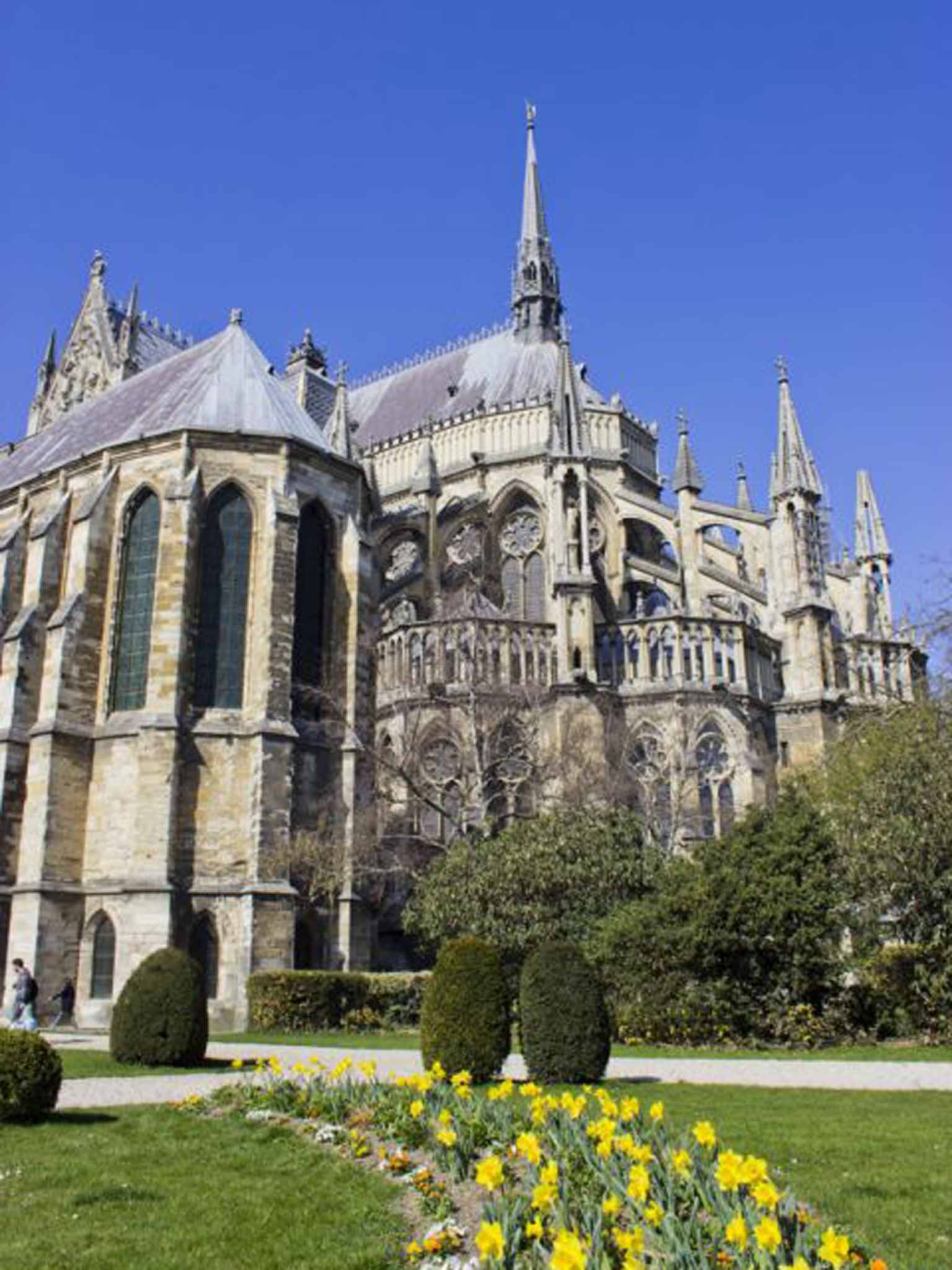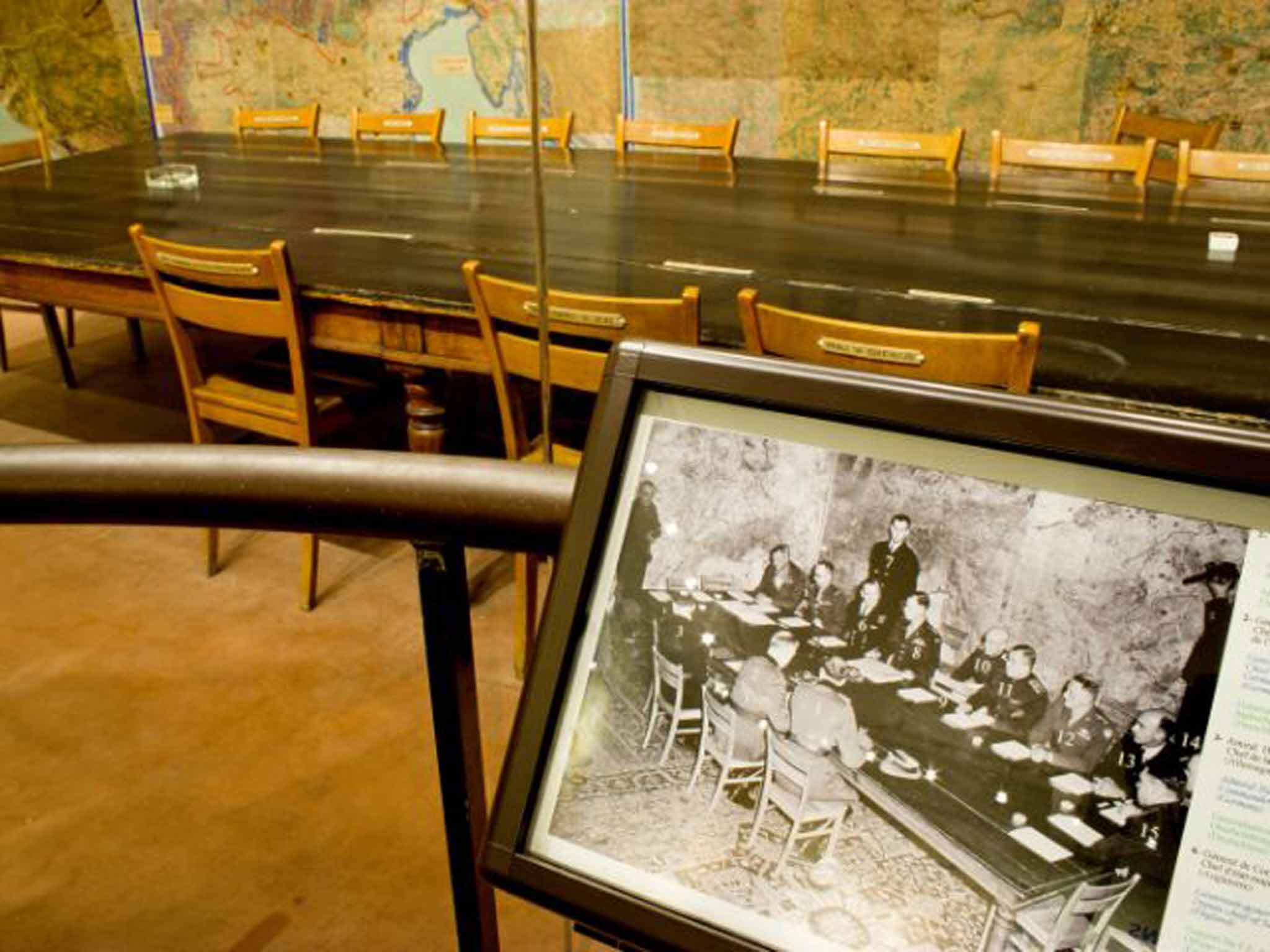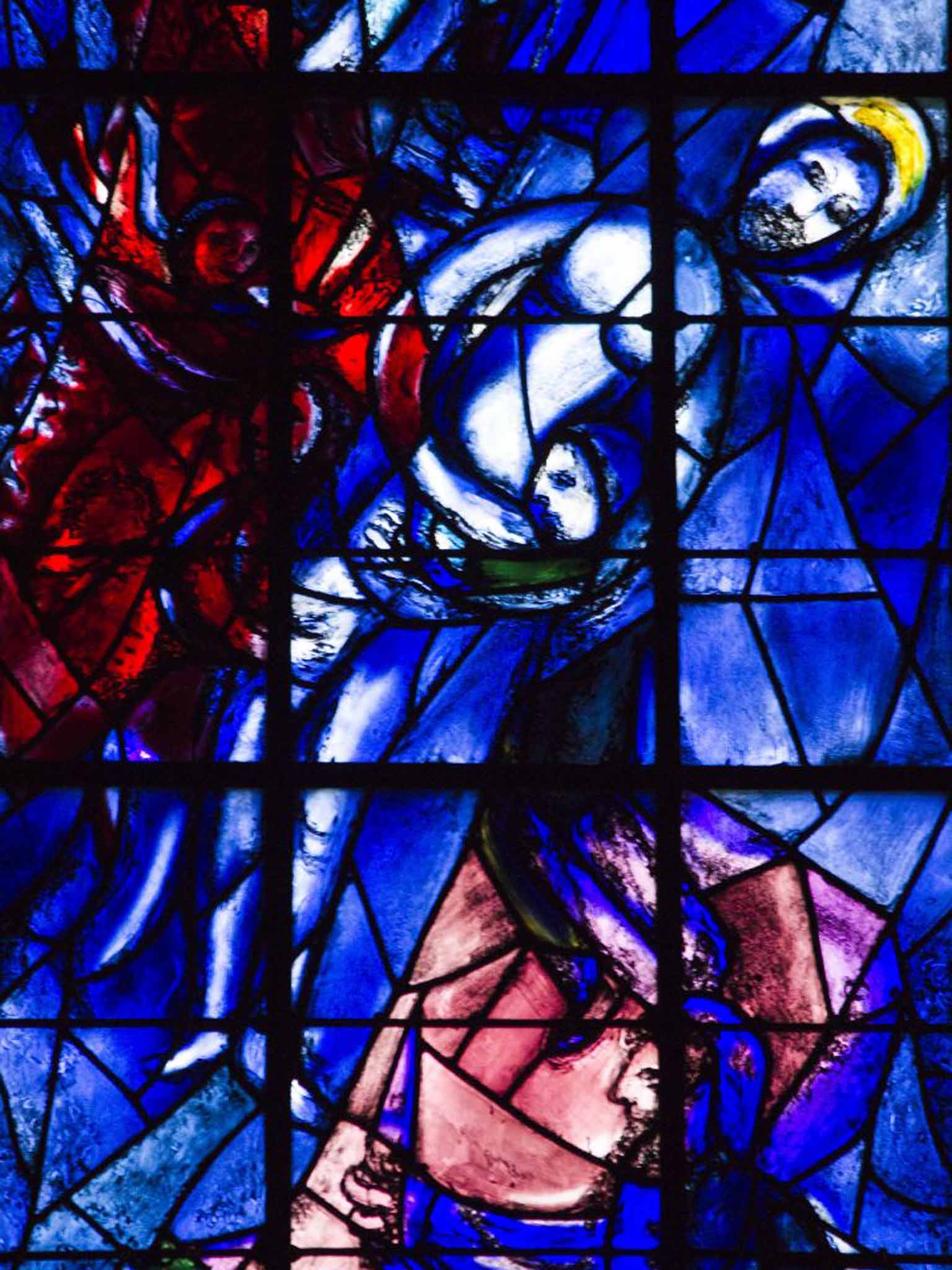The Independent's journalism is supported by our readers. When you purchase through links on our site, we may earn commission.
Reims, Champagne's capital, the city of surrender
The Second World War in Europe ended in Reims 70 years ago this week, a momentous occasion that has had to fight to be remembered, says Chris Leadbeater

For several minutes, I am convinced I have gone the wrong way. The cobbled lanes of medieval Reims have faded behind me, the twin towers of its cathedral drifting into the distance. I have crossed the wide grass of Les Promenades, the mile-long curve of park which delineates the upper edge of the centre – in doing so, passing beneath the strong shoulders of the Porte de Mars, the 3rd-century gateway which marked the entrance to the Roman city. And I have wandered over the railway line where fast TGV trains link the capital of the Champagne region to the grand avenues of Paris, 90 miles to the south-west.
Where, I am starting to ask, is the site which hosted one of the 20th century's main events?
The Musée de la Reddition (Surrender) is literally on the wrong side of the tracks, pinned to the back of the SNCF station where Reims begins to flee into its northern suburbs. And if Rue Franklin Roosevelt, the street in question, bears the name of one of America's most hallowed leaders, there is little else about the area which hints at great men and big deeds.
Yet it was here, in the early hours of 7 May 1945, that Germany formally renounced its assault on the planet, and the Second World War in Europe came to an official conclusion. Seventy years ago, the red-brick structure which dominates this dingy road was the Supreme Headquarters of the Allied Expeditionary Force – General Eisenhower having shifted himself east from Paris as his foe began to fail. A week earlier, on 30 April, Hitler had committed suicide in Berlin – leaving a conflict of unprecedented scale all but done.
Yet Eisenhower's command bunker was not just the nerve centre of the war's last days. It was also a school. And still is – a fact which continues to throw me off the scent, forcing me to wade through the education rituals of a weekday morning, pupils cluttering the pavement outside the Lycée Franklin Roosevelt amid a mass of cigarette butts and chewing gum splotches. It is only when I reach the west end of the building that I find my destination. I know this because of the words, fixed in hard iron (in French) over the door: "It was here that the agreement which finished the Second World War was signed."

It is a statement that needs making. Reims has long had to defend its position in history – had to, almost from the moment it happened. Stalin, puffed up in triumph, was angry that the Allied coup de grâce had been delivered on soil that he had not "liberated". In a surge of dark theatre which would evolve into the Cold War, he demanded a further signing, a day later, at the core of the beaten Third Reich. His wish was granted in the Lichtenberg district of Berlin – and VE Day took its place in the calendar on 8 May. Reims was partially overshadowed.
It still feels that way as I step into the Musée de la Reddition. It is not a large institution, barely more than three rooms – of which the third is all-important. The chamber where surrender was confirmed has been frozen in time, campaign maps – showing the state of play in Germany, Burma, the Philippines – still covering its walls. Then there is the table, preserved behind glass – not a noble slab of oak, but the sort of unvarnished workhorse you expect to find in a school. Fifteen chairs are still arranged around it – the majority on the far side, where assorted Allied dignitaries awaited the dénouement. On the near side, three chairs linger – those of the Germans, their defeat emphasised by weight of numbers.
An adjacent photograph captures the scene in 1945, the protagonists forever ensnared in black and white – a chorus of American, French, British and Russian soldiers. One man, though, is missing. Eisenhower, famously, did not attend. Explanations as to his absence vary – that he found the process distasteful; that, with Admiral Karl Doenitz, the new German head of state, busy elsewhere, there was no one of sufficient rank at the table to justify his presence. So he skulked upstairs, leaving matters to his chief of staff, General Walter Bedell Smith, as – at 2.41am – Generaloberst Alfred Jodl, the head of Germany's armed forces, provided the crucial swirl of the pen. From that second, these three men were bent on different paths. Eisenhower would serve as the 34th US President from 1953 to 1961, with Smith – who would become director of the CIA in 1950 – as a prominent part of his team; Jodl would be tried as a war criminal at Nuremberg, and hanged on 16 October 1946.

Eisenhower is there elsewhere, though, in the few exhibits which comprise the rest of the museum – a shot of the aftermath where he grins for the camera, holding two pens in a "V for Victory" shape; another of him being inducted as a "citizen of honour" at Reims' Hotel de Ville on 12 May, a line of champagne glasses at the front of picture. Other artefacts give a little more context – the jubilant front pages of various European newspapers on 7 May; a transcript of the instrument of surrender (in English) originally sent to Doenitz, and found among his papers in 1977.
There will be further commentary in the coming week – via a "peace festival" which, over four days (6-9 May), will carry Reims back to 1945. The museum will stay open on the night of 6-7 May to let visitors be there at 2.41am. The Parc de Champagne, south-east of the centre, will witness the recreation of an American military camp. And a son et lumière show will wash over the Monument aux Morts – a calm tribute to the war's dead, located at the north tip of Les Promenades.
Photographs are also currently on display in the Place du Forum, the square that beat as Reims' heart when it was the Gallo-Roman settlement of Durocortorum. Here are telling images – US troops marching through in August 1944, locals savouring their deliverance. Gazing at these faces, farmers in from the vineyards which frame the city, the equation briefly strikes me as incongruous – dark times in a city best known for the light golden colour of its most celebrated product; hard truths in the home of soft champagne bubbles.
Yet in many ways, Reims has been defined by war and despair. And it merited its day on the pantheon at the end of the Second World War – because of how it suffered in the First.
It was one of the main urban victims of 1914-1918, its position (almost) on the front line leaving it 80 per cent ruined by the time of the Armistice. However, if Reims was a corpse in 1918, it was the comeback kid of the 1920s, reborn in that decade's fine style. Bursts of Art Deco greet you everywhere – marble flourishes on elegant apartments, mosaics on sumptuous facades. This is especially the case on Rue du Temple, where the Hôtel des Ventes is a swirl of blue and gold fragments, its upper floors still active as an auction house, its ground level given over to bars and restaurants – locals chatting at champagne specialist Le Clos. Alongside, Les Halles du Boulingrin is a market hall, opened in 1929, whose white concrete soars into the heavens.
When I wander into the centre, I find the crown jewel. The Bibliotheque de Reims was a gift to the city – funded by US industrialist Andrew Carnegie – which emerged in 1928. It looks like something from F Scott Fitzgerald's dreams – a wrought-iron gateway, a lobby encased in marble where a pale chandelier of remarkable beauty holds court; a reading room where light seeps in through intricate windows of green and yellow tiling. I am still captivated by the building as I drift to the nearby Café du Palais – a popular lunch spot where half the city seems to be eating laden plates of charcuterie – and encounter more of the same, the glass canopy above my head giddy with the bright outlines of birds in flight.
From my table, I can see Notre Dame, the 13th-century cathedral which acted as the soul of pre-Revolutionary France, staging the coronations of its monarchs. It died on 20 September 1914, brow-beaten by a German artillery attack which caused its roof to melt and its gargoyles to vomit molten lead. Its resurrection was slow, painful – although not without compensations. Behind the altar, in a rear chapel, three stained-glass windows bear the fingerprints of Marc Chagall – a triumvirate of biblical scenes which were crafted between 1968 and 1974 to replace a set of 19th-century panes eaten by the flames.
They are an emblem of healing. There is another in the flagstones outside the main entrance, a plaque which recalls 8 July 1962 – the day that Charles de Gaulle and Konrad Adenauer met at the cathedral, the leaders of France and Germany symbolising the two countries' reconciliation by attending mass together. Explaining the choice of location, De Gaulle would later describe the city as a "theatre of many clashes". Do not be fooled by the champagne in your glass – Reims has always been a main course, not just an aperitif.
Getting there
Reims lies an hour beyond Paris by train, and is most easily reached by rail. Tickets available through Eurostar (03432 186186; eurostar.com) or Voyages SNCF (0844 848 5848; uk.voyages-sncf.com).
Airlines operating to Paris Charles de Gaulle include British Airways (0844 493 0787; ba.com), easyJet (0330 365 5000; easyJet.com), Cityjet (0871 405 2020; cityjet.com), Air France (020 7660 0337; airfrance.co.uk) and Flybe (0371 700 2000; flybe.com).
Visiting there
Musée de la Reddition, 12 Rue Franklin Roosevelt (00 33 3 2647 8419; reims.fr). Daily except Tuesday (closed), 10am-noon and 2-6pm; €4 (£2.90).
Bibliotheque de Reims, 2 Place Carnegie (00 33 3 2677 8141; bm-reims.fr). Daily 10am-1pm and 2-7pm, except Monday (closed) and Thursday (2-7pm only); free.
Cathedrale Notre Dame de Reims, Place du Cardinal Lucon (00 33 3 2647 5534; cathedrale-reims.com). Daily 7.30am-7.30pm; free.
Eating there
Cafe du Palais, 14 Place Myron-Herrick (00 33 3 2647 5254; cafedupalais.fr).
Staying there
Hotel Azur, 9 Rue des Ecrevées (00 33 3 2647 4339; hotel-azur-reims.com). Double rooms from €69 (£49.50), room only.
More information
More on the peace festival at reims.fr
Join our commenting forum
Join thought-provoking conversations, follow other Independent readers and see their replies
Comments